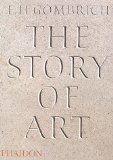“The Story of Art” by E. H. Gombrich is a classic and popular book that charts the evolution of art through the ages. Using a plain language and written in a non-condescending style (sadly quite rare for the art books that I have seen in my life), it is a book that I wish I had read much earlier in my life. It would make a great gift for a teenager to gently initiate them into the wonderful world of art.
The book mostly covers paintings, sculptures and architecture in its coverage of art. The period covered begins from pre-historic times and ends in modern times. As the author himself acknowledges, the book almost exclusively deals with western art in order to keep its size manageable. Within these limits, it does a splendid job of noting the contexts in which art developed, which provides valuable insights into the development of particular styles. You cannot fully appreciate a work of art without understanding the context in which it was created.
The book has more than 400 illustrations, works of art reproduced in full colour, that aid the text. In the main editions, these are put right next to the relevant text for easy reference; in the pocket edition, these are collected in a set of plates towards the end of the book in order to reduce its bulk. The pocket edition has two ribbon bookmarks so that you can keep track of your place in the text as well as in the set of plates. Flipping back and forth between the two as you read the text becomes painful after a while, but that's the price you pay for a less bulkier (and cheaper) edition of the book. Unless you want to read this book while travelling, I would suggest that you get one of the main editions (which are much heavier and, of course, more expensive than the pocket edition).
I fully agree with the author that the illustrations, all of them scaled down reproductions, do not do full justice to the respective works of art. I have had the privilege of viewing many of these works in person and no photograph or video properly captures the colours or scale or texture or the brush-strokes (in case of a painting) of a work of art. For example, something like a painting on the ceiling of a chapel is best appreciated in situ and in the normal lighting for the place. Of course, this involves a fair bit of travel, which is not possible for all of us. As the author notes, this is one of the biggest challenges for a lover of art.
While the author keeps referring to various elements of the composition of different works of art, he does not fully elucidate either the elements or the principles of art. You get a general idea of these things, but you'll have to look elsewhere for a fuller exposition. This is understandable in a book on the history of art. It is also understandable when you consider that these are not considered sacrosanct in modern art.
If you read this book looking to “understand” abstract art, you will be disappointed; I certainly was. The author uses a somewhat vague language to describe such art and very carefully tries to not pass a judgement on such art. His defence is somewhat credible in that enough time has not passed for us to judge “modern art” and to sort its place out in the grand history of art.
There is an essay in the final chapter of the book where the author ponders over the current state of art. He highlights the shift away from representationalism possibly as a reaction to the fidelity with which a camera captures a picture in modern times. He notes the widespread non-conformist attitudes of modern artists and a “rebellion against the rebellion” of some of the modern artists in going back to representationalism.
This is the sort of book that every person ought to have on their bookshelves. I would certainly recommend that you read such a book before you visit art museums in order to appreciate the context in which art was created. After you read this book, make it a point to visit the art museums in a city you travel to. It is quite an enriching experience.
